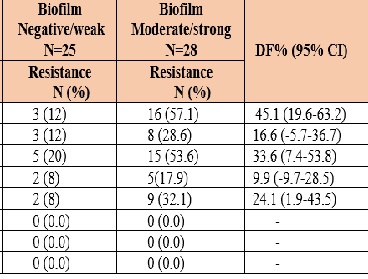In vitro sensitivity of Candida albicans isolates to antifungal agents and the effect of biofilms on the drug resistance rate
Main Article Content
Abstract
Background and objectives: The pathogenic species that is most frequently isolated from fungus infections is Candida albicans. The host's immune system, the severity of the infection, and the antifungal medication of choice all influence the management of these infections. Despite the advancement of novel antifungal medications, epidemiological investigations have demonstrated that resistance to antifungal agents in C. albicans strains is becoming a significant issue. The aims of this study were to (I) determine the prevalence of antifungal resistance in 53 oral Candida albicans isolates and (II) investigate the effect of biofilm production capacity on antifungal resistance rates.
Methods: Fifty-three isolates of Candida albicans were evaluated for biofilm production using the Tissue Culture Plate Method (TCPM). The antifungal susceptibility pattern of these isolates for amphotericin B, caspofungin, anidulafungin, voriconazole, itraconazole, ketoconazole, and posaconazole was determined using the E-test.
Results: The present study showed strong, moderate, weak, and negative biofilm production in 18.9%, 34.0%, 26.4%, and 20.8% of the C. albicans isolates, respectively. Amphotericin B, anidulafungin, and caspofungin effectively inhibited all of the tested isolates. The resistance rates of C. albicans isolates to fluconazole, itraconazole, ketoconazole, voriconazole, and posaconazole were 35.8%, 20.7%, 37.7%, 13.2%, and 20.7%, respectively. Strong and moderate biofilm-producing isolates displayed higher resistance rates compared to weak and negative biofilm producers. The majority of antifungal treatments showed a significant difference (p <0.05)".
Conclusion: Our results suggest that the study area has a higher prevalence of azole-resistant Candida albicans. Thus, there is an urgent need to develop a plan to decrease the overuse and unneeded adverse effects of antifungal medications. Testing for antifungal susceptibility and fungus culture will be helpful in monitoring resistance and providing therapy for patients. It was observed that the development of Candida albicans biofilms was correlated with the drug resistance component of oral Candida albicans isolates.
Downloads
Article Details

This work is licensed under a Creative Commons Attribution-NonCommercial-NoDerivatives 4.0 International License.

